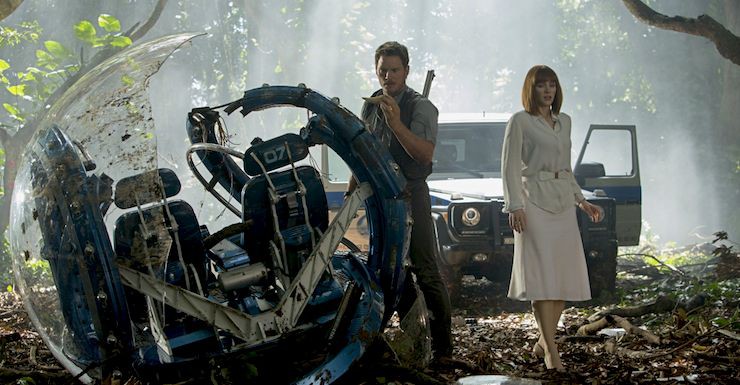It’s hard to beat the majesty of a Tyrannosaurus. The “tyrant lizard” is a must-have for any dinosaur park. But it’s not exactly the safest dinosaur to keep—the Isla Nublar incident of 1993 is all the evidence you need of that. And even some of the seemingly more docile dinosaurs can still be a handful. You wouldn’t want visitors to be crushed beneath the feet of an Apatosaurus that wasn’t watching where it was going, or to be impaled on the tail spikes of a Stegosaurus who woke up in a bad mood. When it comes to park safety, at least, big isn’t best.
Fortunately, paleontologists have uncovered a wealth of smaller dinosaurs that would be more suitable for up-close interactions. Some are veggisaurs. Some are not. But here are ten candidates that would be fitting for the petting zoo portion of Jurassic World.

Chilesaurus
This little dinosaur was announced just a few months ago. Found in the 150 million year old rock of South America, Chilesaurus was a turkey-sized member of the theropod lineage – the group that contains all the carnivorous dinosaurs – but, unlike most of its relatives, the little dinosaur went vegetarian. The leaf-shaped teeth in its mouth were better suited to nipping leaves than slicing flesh, and the dinosaur’s short-snouted, big-eyed look certainly help its “Aww” factor.

Yi
Think of this critter as the dinosaur equivalent of a flying squirrel. This fluffy little dinosaur, discovered in the 163 million year old stone of China, had elongated bones and its wrists that supported flaps of skin that would have allowed Yi to glide through the air. And given that Yi was about the size of a pigeon, it’d be far more interested in catching insects than dining on humans.

Magyarosaurus
You can’t have a dinosaur park without a sauropod, and Magyarosaurus offers a safer, scaled-down option compared to some of its enormous cousins. This 70 million year old dinosaur was what scientists term an “insular dwarf” – a species that shrunk in size during its time cordoned off on an island. Adults of this species only grew to about 20 feet long, which would make them just about the right size to offer dino-back rides.
Shuvuuia
Anteaters are common zoo attractions, so why not have an ant-eating dinosaur? Around two feet in length, Shuvuuia was a fuzzy little theropod with short, stout claws for scratching open insect nests and an elongated snout fitted with tiny teeth. And covered in soft, filamentous fuzz, it’d certainly be one of the more adorable additions to the park.

Panphagia
We often think of sauropod dinosaurs as long-necked giants, but they started off as small, slender dinosaurs that ran around on two legs. Panphagia, found in the 231 million year old strata of Argentina, provides a picture of what the earliest predecessors of Apatosaurus looked like, not to mention that it’s one of the oldest dinosaurs currently known. That alone would make six-foot-long Panphagia a rockstar addition to Jurassic World.
Lesothosaurus
Lesothosaurus didn’t have any crazy horns, plates, wings, or other bizarre structures. What this five-foot-long, 200 million year old dinosaur excelled at was being generally adorable. And given that little ornithischian dinosaurs like this are often passed over, I think it’s about time that they get some love rather than being depicted as theropod chow.
Scutellosaurus
This was one tough little dinosaur. Found in the 200 million year old rock of Arizona, Scutellosaurus was one of the earliest armored dinosaurs. Rounded and triangular osteoderms – skin bones – dotted its four-foot-long body, and, while its later cousins like Stegosaurus would trundle around on all fours, Scutellosaurus was a lithe little dinosaur that ran on two feet.
Wannanosaurus
Wannanosaurus might seem like a riskier choice. It was one of the dome-headed pachycephalosaurs – the dinosaurs often depicted slamming their thickened skulls together. At three feet long, though, the 80 million year old Wannanosaurus would be less of a threat than its larger relatives. And if head-butting goats are regular petting zoo staples, why couldn’t Wannanosaurus play the same role?

Tethyshadros
Letting visitors amble among the “duck-billed” hadrosaurs suffers the same problem as with sauropods. The likes of Edmontosaurus are just so big they’re unlikely to pay much attention to us comparatively puny humans. At about 13 feet long, the 71 million year old Tethyshadros offers the same hadrosaur popularity at a more manageable size, not to mention that it still had a little bit of hadrosaur flair in the form of a distinctively-ridged beak.

Sinosauropteryx
Everyone loves cats. What could be better, then, than the dinosaur version of a kitten? While, much like felines, the three-foot-long Sinosauropteryx was pointy on five ends (teeth and claws times four), the small theropod was also covered by a pelt of simple, fluffy protofeathers. Just mind your fingertips around those little jaws.
Brian Switek is the author of My Beloved Brontosaurus (out in paperback from Scientific American/Farrar, Straus and Giroux) and Written in Stone. He also writes the National Geographic blog Laelaps.














